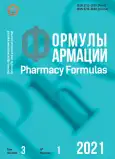Comparative bioelectronic diagnostics of the ecological state of contaminated water areas (on the example of some ducts of the Volga River Delta)
- Authors: Kholodkevich S.V.1,2, Motruk M.K.1, Lyubimtsev V.A.2, Susloparova O.N.2,3
-
Affiliations:
- Saint Petersburg State University
- Scientific Research Center for Ecological Safety of the Russian Academy of Sciences
- Saint Petersburg branch of the Federal State Budgetary Scientific Institution “All-Russian Research Institute of Fisheries and Oceanography” named after L.S. Berg
- Issue: Vol 3, No 1 (2021)
- Pages: 84-91
- Section: Biological sciences
- URL: https://journals.rcsi.science/PharmForm/article/view/63741
- DOI: https://doi.org/10.17816/phf63741
- ID: 63741
Cite item
Full Text
Abstract
Three Volga river delta ducts located in the city of Astrakhan and the Astrakhan region were chosen as objects for bioindication of the ecological status. The aim of the study was to carry out comparative bioelectronic diagnotics of the ecological status of the branches with different size and type of antropogenic load. The assessment was based on the physiological state (health) of the inhabitants – bivalve mollusc Anodonta anatine. The analysis of heart rate of the molluscs was implemented by the fiber-optic bioelectronic system. It has been found that Anodonta anatine collected demonstrate different heart rate recovery time after a 1-hour functional loading within 117–166 minutes. This is the case in mussels inhabiting significantly polluted water areas with the “Bad” ecological status. This characteristic of the water areas fully coincides with the ecological status of the Volga river delta ducts, according to the State report “On the state and protection of the environment in the Russian Federation in 2017”. In this report, the authors propose and substantiate the possibility of using the water area of the Gandurino River as a conditional reference duct for the Volga river delta region. In this case, by the value of the Ecological Quality Ratio (EQR),the status of the Gorodskoy and Maly ducts may be considered as “Good” regional ecological status.
Full Text
##article.viewOnOriginalSite##About the authors
Sergey V. Kholodkevich
Saint Petersburg State University; Scientific Research Center for Ecological Safety of the Russian Academy of Sciences
Author for correspondence.
Email: kholodkevich@mail.ru
ORCID iD: 0000-0002-7561-9743
D. Sc. In Engineering, Professor, Saint Petersburg State University; Chief Researcher, Head of the Laboratory of Bioelectronic Methods for Geo-Ecological Monitoring of Scientific Research Center for Ecological Safety of the Russian Academy of Sciences
Russian Federation, Saint Petersburg; Saint PetersburgMaxim K. Motruk
Saint Petersburg State University
Email: maximotruc@mail.ru
Master Student, Saint Petersburg State University
Russian Federation, Saint PetersburgVasiliy A. Lyubimtsev
Scientific Research Center for Ecological Safety of the Russian Academy of Sciences
Email: lyubimcev55@mail.ru
Ph.D. in Physics and Mathematics, Senior Researcher of the Laboratory of BioelectronicMethods for Geo-Ecological Monitoring of Scientific Research Center for Ecological Safety of the Russian Academy of Sciences
Russian Federation, Saint PetersburgOlga N. Susloparova
Scientific Research Center for Ecological Safety of the Russian Academy of Sciences; Saint Petersburg branch of the Federal State Budgetary Scientific Institution “All-Russian Research Institute of Fisheries and Oceanography” named after L.S. Berg
Email: olga_susloparova@mail.ru
Ph.D. in Biology, Adviser to the Manager,Saint Petersburg branch of the Federal State Budgetary Scientific Institution “All-Russian Research Institute of Fisheries and Oceanography” named after L.S. Berg, Leading Researcher of the Scientific Research Center for Ecological Safety of the Russian Academy of Sciences
Russian Federation, Saint Petersburg; Saint PetersburgReferences
- Государственный доклад «О состоянии и об охране окружающей среды Российской Федерации в 2017 году». Москва: Минприроды России; НПП «Кадастр», 2018. – 888 с.
- Дедикова, Т.Н. Экологическое состояние реки Волги / Т.Н. Дедикова, П.И. Бухарицин // Вестник Астраханского государственного технического университета. – 2015. – № 1 (49). – С. 85–87.
- Косолапов, Д.Б. Экологическое состояние водохранилищ Волги и Дона методом биоиндикации / Д.Б. Косолапов, В.А. Девисилов, Д.А. Новиков [и др.] // Безопасность в техносфере. – 2018. – Т. 7. – № 2. – С. 3–9.
- Холодкевич, С.В. Новый методологический подход к оперативной оценке экологического состояния прибрежных морских акваторий / С.В. Холодкевич, Т.В. Кузнецова, А.С. Куракин [и др.] // Известия ТИНРО. – 2018. – Т. 194. – С. 215–238.
- Холодкевич, С.В. Оценка качества пресноводных экосистем по функциональному состоянию двухстворчатых моллюсков / С.В. Холодкевич, А.Н. Шаров, Г.М. Чуйко [и др.] // Водные ресурсы.– 2019. – Т. 46. – № 2. – C. 209–219.
- Иванов, В.П. Биологические ресурсы Каспийского моря / В.П. Иванов. – Астрахань: Издательство КаспНИИРХ, 2000. – 100 с.
- Израэль, Ю.А. Проблемы антропогенной экологии / Ю.А. Израэль // Научные аспекты экологических проблем России: коллективная монография / под общей редакцией акад. Ю.А. Израэля и проф. Н.Г. Рыбальского. – Москва: Наука, 2002. – Т. 1. – С. 9–21.
- Алимов, А.Ф. Элементы теории функционирования водных экосистем / А.Ф. Алимов. – Санкт-Петербург: Наука, 2000. – 147 с.
- Kholodkevich SV, Ivanov AV, Kornienko EL, Kurakin AS, inventors. Method of biological environment monitoring (versions) and a system for realization thereof. US Patent No. 8442809, 2013.
- Kholodkevich SV, Ivanov AV, Kurakin AS, et al. Real time biomonitoring of surface water toxicity level at water supply stations. Environmental Bioindicators. 2008; 3 (1): 23–34. doi: 10.1080/15555270701885747
- Холодкевич, С.В. Перспективы и проблемы использования биоэлектронных систем в мониторинге экологической безопасности акваторий Финского залива беспозвоночных / С.В. Холодкевич, А.Н. Шаров, Т.В. Кузнецова // Региональная экология. – 2015. – № 2 (37). – С. 16–26.
- Turja R, Höher N, Snoeijs P, et al. A multibiomarker approach to the assessment of pollution impacts in two Baltic Sea coastal areas in Sweden using caged mussels (Mytilus trossulus). Science of the Total Environment. 2014; 473–474: 398–409. doi: 10.1016/j.scitotenv.2013.12.038.
- Kuznetsova TV, Kholodkevich SV. Comparative assessment of surface water quality through evaluation of physiological state of bioindicator species: searching new biomarkers. Proceedings of the 4th Mediterranean Conference on Embedded Computing (MECO); 2015 June 14-18; Budva, Montenegro. IEEE, 2015; 339–44. doi: 10.1109/MECO.2015.7181938.
- Семенченко, В.П. Экологическое качество поверхностных вод / В.П. Семенченко, В.И. Разлуцкий. – 2-е изд., испр. – Минск: Беларус. наука, 2011. – 329 с.
Supplementary files
















